How to Use Learning Journeys to Facilitate Student-Led Learning
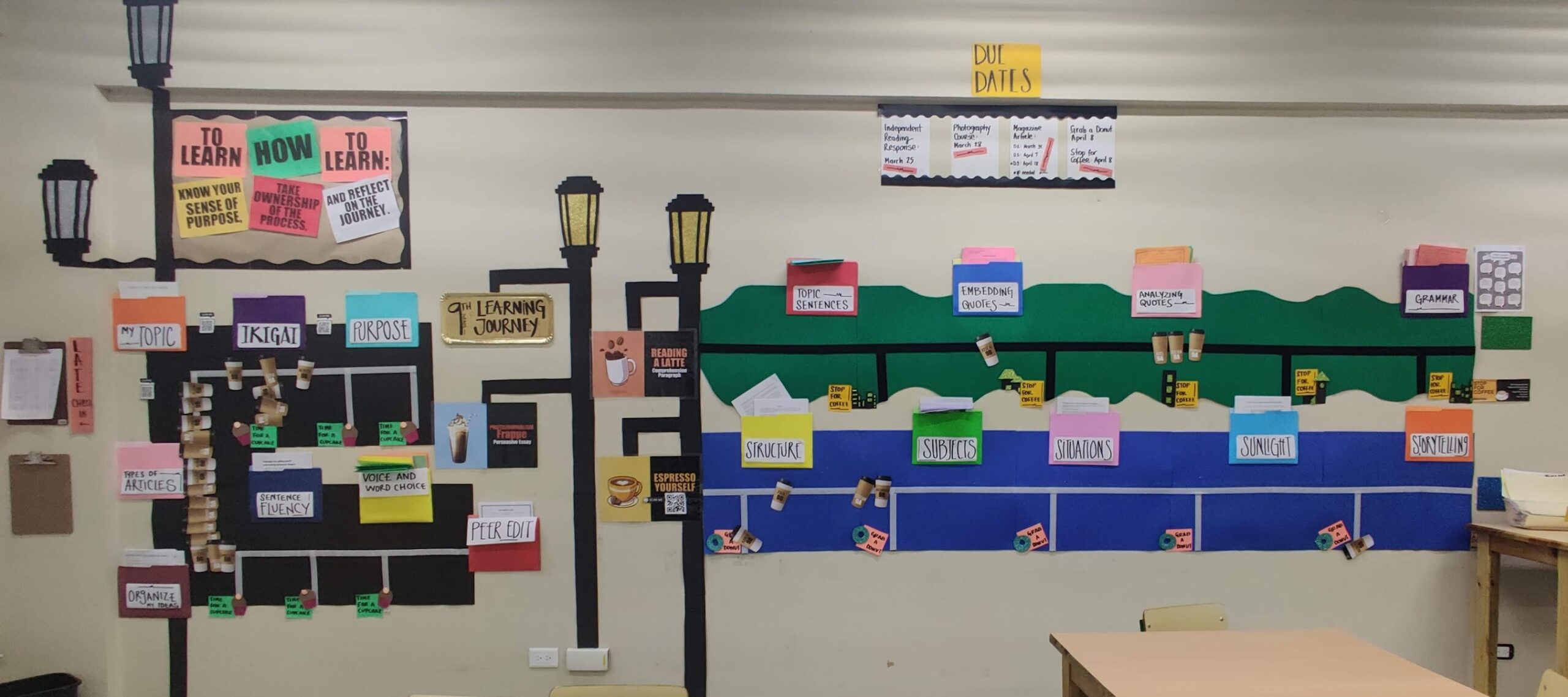
After spending a year and a half in remote learning, many of our students were having difficulty returning to the classroom. They were unmotivated and unable to focus. Our teachers knew they needed to empower their students if they wanted to engage them in learning. For this reason, in our weekly Inquiry based PD , a group of teachers chose to work on student-led learning, focusing on having students set goals for themselves, reflect on their learning and self-assess.
During one of our sessions, teachers watched a video about a second grade math teacher who shares the use of learning paths for self-paced instruction. Nicole Jorge, our 9th grade language arts teacher, was inspired to try this for her own students.
Nicole and I met to brainstorm ideas for creating what she called a “learning journey” for her students. We considered making it digital but Nicole really wanted to motivate her students with a visual on the wall of her classroom. She also felt that her students needed the opportunity to get up and move around the room. She eventually came up with creating 3 pathways which would cover the next three assignments her students needed to complete.
Components:
-
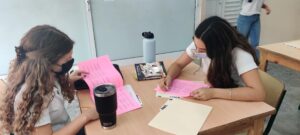
Students self-assess their life skills before writing a progress report comment.
Each pathway has a series of folders containing rubrics and the information students need to master their assignment. Normally Nicole would present this information in mini-lessons but she decided to let students work on their own; she would meet individually or in small groups with those who might need support. Students choose the information they need from the learning path and then work in independently or in groups.
- The pathways have a velcro stripe down the middle and since the theme of Nicole’s classroom is the Literary Cafe, each student has a “coffee cup” which they can place along the path. They put the coffee cup underneath the mini-lesson they’re working on, or on one of the optional assignments. At a glance, Nicole can see what students are focused on.
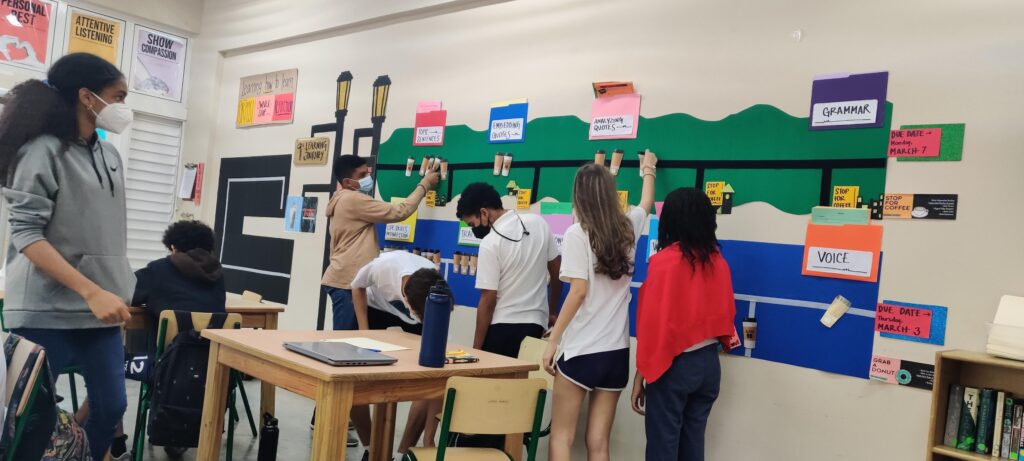
- The due dates for assignments are clearly posted so that students can plan their work.
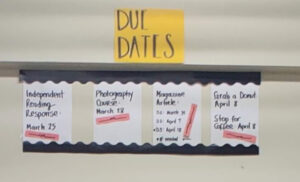
- Along the pathways there are optional assignments:
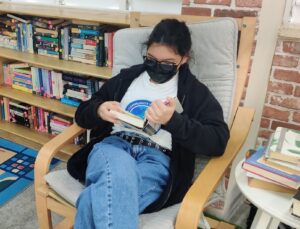
Student chooses to read independently,
- “Stop for coffee” is independent reading. Students can read for 15-20 minutes or work on an independent reading response.
- “Grab a donut” is a free writing station with a variety of ideas or one they can create on their own.
- Grammar – students choose a grammar lesson they need in order to improve their drafts. Nicole highlights grammar errors in a variety of colours and grammar mini-lessons are colour-coded. So, for instance, if a student sees that several sentences are highlighted in yellow, they can choose the yellow grammar sheet which will be a lesson on run-on sentences. This way, grammar lessons are directly applicable to students’ writing pieces.
- One of their assignments is a photojournalism essay. QR codes on the learning path, bring students to a free online course on photography.
- Students can find all components of the learning path that are on the wall on Google classroom. So if they’re at home, or if they prefer digital learning, they can also access the lessons online.
- Sticking with the Literary Cafe theme, students who master a skill become “baristas” that other students can ask for help.
Organizing the work;
- Students have folders in which they place their post-it notes from entrance slips and exit slips. They complete the mini-lessons they keep the information in their folders as well.
- They have a road map where they can check off completed steps in the assignments.
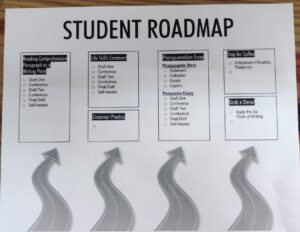
- They each have a planning form. At the beginning of class they decide what they’ll work on and why. At the end of class they reflect on their progress that day.
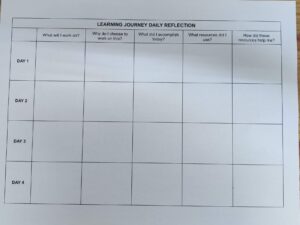
Daily planning and reflection
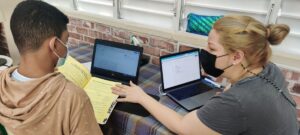
- When Nicole conferences with students, if necessary, she can guide them to the mini-lessons they need at the moment.
Mini-lessons
- As Nicole reads through students’ work she decides what kinds of mini-lessons they need, and prepares them to add to the wall.
- Occasionally, she gives whole group mini-lessons at the beginning of class. But, she says, these tend to be more life skill related, than content related. For instance at the beginning of student-led learning she found that students needed help understanding what having a purpose entailed and how to reflect meaningfully on their learning. So those became the focus of some of her mini-lessons.
- Nicole created a Google form on which students can tell her what they’re interested in learning. This way she can even further tailor her lessons to their needs.
The Pros:
- Preparing the learning journey took some work upfront, but once it was ready, Nicole didn’t have to do much daily planning, other than creating a few mini-lessons. Rather than planning, she simply keeps track of where students are at and spends most of her time giving feedback. She also finds that she has much more time to conference with her students, giving extra time to those who need more support.
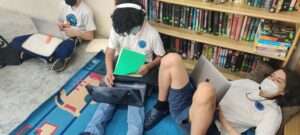 Students are highly engaged. When I walk into the room, I hear a hum of activity. Some students are working on their reading responses: honing their topic sentences or working on deeper analysis. Other students are self-assessing their life skills in order to write their progress report comments, or they’re working on improving their word choice. In the corner, I see two students curled up with books. But for the entire seventy minutes, students are working.
Students are highly engaged. When I walk into the room, I hear a hum of activity. Some students are working on their reading responses: honing their topic sentences or working on deeper analysis. Other students are self-assessing their life skills in order to write their progress report comments, or they’re working on improving their word choice. In the corner, I see two students curled up with books. But for the entire seventy minutes, students are working.- Students can move at their own pace, so that they constantly feel challenged without feeling overwhelmed.
The Cons:
- At first it was scary. Nicole was very nervous about trying this with her students. “What if they don’t respond? What if they just don’t work?” She had to remind herself that in her more traditional classroom, about half the class wasn’t actually working anyway, and that most of those who were working were simply complying; very few seemed authentically engaged in their work. Taking the risk was hard, but in the end, it was so worth it.
- Two students struggled with this form of learning. Both of them are normally strong students, but both felt at a loss if they weren’t told exactly what to do each day. One of them said, “I like it the way it was before. I liked it when the teacher told me what to do and I didn’t have to choose. When you just have one thing to do, it’s far simpler. You don’t have to think.” This was an eye-opener for Nicole and she has spent time teaching them time management and self-advocacy skills.
Student reactions were incredibly positive. We interviewed them and, except for the two students mentioned above, all of them said, “I love learning like this!!” Their reasons:
- “I can choose what to do and work on what I really want to work on. Getting the mini-lessons on my own helps. Maybe I have some doubts. But I can always ask.”
- “I can find my own process for learning and what works for me.”
- “I like being independent.”
- “We can choose what we want to learn and express ourselves. So it feels more like I’m discovering who I am and what I need.”
- “Before when the teacher taught a lesson there would be people who already knew, so it wasted their time and then there were people who weren’t ready for it yet, so they felt lost. This way everyone is learning what they need to learn when they need to learn it.”
- “Even though I sometimes struggle with procrastination, it’s still positive because I can read and take a break if I want to, which is good for my mental health. For instance, today I was all caught up on my work so I decided just to spend my time reading. That made me feel so good.”
- “I’m improving my skills in time management and organization. I don’t have to worry about LA homework anymore because most of it gets done in class. We use class time better because we start working right away. We don’t have to wait for the teacher to stop talking.”
- “I like it better than the old way of working because we’re doing conferences and they’re guiding me. Before we conferenced about once a week, but now we can conference everyday so I get a lot more support.”
The best response of all: Nicole had planned to work like this for a trimester, but the kids asked her if they could continue working like this for the whole year!!
Follow Nicole Jorge on Twitter: @kidswholit

One of the most valuable responses came from one of the two struggling students. A few days ago, he approached me to let me know that 9th graders love the learning journey. When I pointed out that he did not, he corrected me and said that he does now. He did not at first because he needed to get used to it. He said that now he gets to conference with me on a daily basis and has learned life skills (like time management and setting priorities) that have helped him excel.
This is the best feedback you could have received, Nicole! I’ve never seen an entire class completely engaged for over a month. Just amazing!